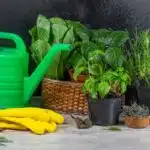The elusive cilantro, or coriander, is a unique herb that has been used for culinary and medicinal purposes for centuries. Its delicate leaves are often overlooked in the garden, but with proper care and attention, these plants can provide a wonderful addition to any indoor space. This article will provide an overview of cilantro’s indoor care needs and growing guide so you can add this valuable herb to your home garden.
For those who are already familiar with cilantro, they know that it can be quite difficult to grow indoors due to its preference for warm weather and direct sunlight. However, with the right tips and tricks, any gardener can successfully cultivate cilantro in their own home. Cilantro is a great choice for both beginner gardeners as well as experienced horticulturalists who want to add some unique flavor to their indoor gardens.
In this comprehensive guide, we’ll discuss all aspects of cilantro’s indoor care needs including soil type, watering requirements, temperature range, light exposure and more. We’ll also cover various methods of propagation as well as troubleshooting tips for common problems such as pests or diseases. By the end of this article you should have all the information needed to ensure successful cultivation of cilantro indoors. So let’s get started!
Choosing The Right Plant
The colour and aroma of cilantro is like a gift from nature. The bright green leaves, the delicate stems and the softness of its foliage make it a perfect addition to any home. Cilantro is easy to care for and can thrive indoors with just a few simple steps.
When choosing a plant, look for one that has bright green leaves, healthy stems and no signs of disease or damage. It should also be free from pests or other organisms that can harm the plant. Also consider the size of the pot you will be using – large plants may need more space than smaller ones. You should also check that it’s well-draining soil, as cilantro prefers moist but not soggy conditions.
Once you’ve found an ideal specimen, prepare your potting soil by mixing equal parts peat moss, compost and perlite for excellent drainage. Place your cilantro in the center of the pot and fill it with soil up to about two inches below the rim. If you are planting from seeds, spread them evenly across the surface of the soil before adding water. This will help ensure even germination rates and better growth overall.
Cilantro needs plenty of light to flourish – place it near a sunny window or use artificial light sources such as grow lights if necessary. Water regularly to keep the soil moist but not soaking wet – this will prevent root rot and other problems caused by overwatering. Fertilize every couple weeks during its growing season with an organic fertilizer for best results. With proper care, your cilantro can bring beauty and flavor into your home all year long!
Planting Cilantro From Seeds
Ah, planting cilantro from seeds. The ultimate test of a gardener’s mettle – the pinnacle of their craft. But fear not! With a few simple steps, any aspiring green thumb can make a success of this endeavor.
To begin with, one should always select high-quality organic seeds to ensure optimal growth and health. When it comes to cilantro, this is especially important since the plant is notoriously picky about its environment. Also be sure to check the expected germination rate on the packet in order to determine how many seeds must be planted for each pot or bed.
Once the seeds are selected and acquired, the next step is to prepare the soil for planting. This means adding compost or well-rotted manure to enrich the soil and ensuring that it drains well. Cilantro prefers loamy soil with an acidic pH between 5.5 and 6.8, so consider using pH testing kits in order to make sure your soil is within range before sowing your seeds. Planting them shallowly – only 1/4 inch deep – will also help ensure successful germination.
Finally, you’ll want to provide your cilantro plants with consistent moisture throughout their growing season; about 1 inch per week is ideal for most climates, either through regular watering or natural precipitation if you live in an area with reliable rainfall. Creating a mulch barrier around each seedling can also help conserve water and keep weeds at bay during this critical stage of development…
Planting Cilantro From Transplants
Once you have the transplants, planting cilantro is quite easy. First, find a pot with drainage holes and fill it with a light and well-draining potting mix. Then, make sure to moisten the soil before placing the transplant in the pot. For optimal growth, space the plants at least ten inches apart from one another. Here’s what you should keep in mind when planting cilantro from transplants:
• Place the transplant in the center of each pot to ensure proper airflow around it. • Make sure to press down gently on the soil after planting to remove any air pockets that can cause root rot. • Water your cilantro plants immediately after planting and then monitor them regularly for moisture levels.
This simple process will help you get your cilantro off to an excellent start and set it up for success as it matures into a full-grown plant. With its bright leaves and distinctive flavor, cilantro can be a great addition to any garden or patio – just make sure you give it enough sunlight and water!
Now that you know how to plant cilantro from transplants, let’s take a look at how much sunlight your plants need in order to thrive indoors or outdoors.
How Much Sunlight Does Cilantro Need?
Cilantro, the popular herb from the Apiaceae family, requires a fair amount of sunlight in order to thrive. For optimal growth and health, this plant needs a minimum of six hours of direct sunlight per day. However, it can survive in part shade as well. To ensure your cilantro plants have enough light for them to produce their flavorful leaves, here are a few tips:
• Place the pot near a south-facing window that gets adequate sun throughout the day. • If possible, transfer your cilantro plants outside during sunny days and bring them back indoors during cloudy days or nights. • Utilize artificial lighting for your plants if needed.
As cilantro is susceptible to heat damage and wilting due to its shallow root system, it’s important to be mindful of how much sunlight they receive so they don’t get scorched. Make sure you monitor your plant regularly and adjust its location accordingly depending on the intensity of the sunshine at any given time.
By providing your cilantro with sufficient light exposure with minimal risk of overheating, you can boost its growth rate and maximize herb production! With that said, let’s move onto cilantro’s water needs next.
Water Needs For Cilantro
Water is an essential part of cilantro’s care and growth. It’s a vital resource that will determine the success of your plant, so understanding its needs is key to a successful harvest. Like a life-giving river, getting the right amount of water can make or break your cilantro crop.
So how much water does cilantro need? The answer depends on several factors, including climate, soil type, container size, and light levels. Generally speaking, however, cilantro prefers evenly moist soil and should receive about 1-2 inches of water per week. Here are some tips for properly watering your cilantro:
• Water in the morning or evening when temperatures are cooler. • Feel the top of the soil before watering; if it’s dry to the touch then it’s time to give your plant a drink! • Give plants enough water so that it runs out from the bottom of the pot once or twice each time you water. • Avoid overwatering as this can lead to root rot and nutrient deficiencies. • During hot weather, check your plants daily for signs of wilting and water accordingly.
By following these simple guidelines you can ensure that your cilantro receives just the right amount of hydration needed for optimal health and growth. With proper watering techniques you’ll be well on your way to harvesting healthy and delicious cilantro leaves!
Soil Requirements For Growing Cilantro
When it comes to growing cilantro indoors, soil requirements are paramount. Cilantro is a shallow-rooted herb, meaning that it needs well-draining soil in order to thrive. A lightweight potting mix with some organic matter added is ideal for this purpose. To ensure proper drainage, add some sand or perlite to the mix and make sure there are holes in the bottom of the pot for water to escape.
Furthermore, cilantro requires plenty of nutrients to stay healthy. To provide those nutrients, you’ll want to add a slow-release fertilizer at planting time and occasionally use a liquid fertilizer throughout the growing season. To encourage strong foliage growth, be sure that you don’t overfertilize your cilantro plants as this can lead to weak stems that are prone to disease and pest problems.
By following these steps carefully, you can ensure that your cilantro has all the necessary conditions for success. With regular watering and nutrient support, your cilantro will thrive inside your home – bringing vibrant color and flavor into your life! Now that we know about soil requirements for growing cilantro indoors, let’s turn our attention towards caring for it once it’s been established in its new home.
Caring For Cilantro Indoors
Coriander, or cilantro, is a common herb used in dishes around the world. Growing this savory and fragrant plant indoors can help bring flavor to many of your favorite recipes year-round. To ensure your cilantro has the best chance for success, though, it’s important to understand the basics of caring for it. Let’s dive into the age-old wisdom of providing proper care for cilantro indoors!
First and foremost, your cilantro needs warm temperatures to thrive; no cooler than 65 degrees Fahrenheit is ideal. Beyond that, you’ll want to make sure the light levels remain high throughout its growth process. If you don’t have access to natural sunlight in your home, consider investing in grow lights. Of course, you’ll also need well-draining soil with plenty of organic matter mixed in.
Now that we’ve got all the basics down pat, let’s talk about how to properly care for your indoor cilantro plants once they’re established. To start off, you will want to water them regularly but not too much; making sure they stay moist but not soggy should be at the top of your priority list! On top of that, make sure you are frequently removing any dead or wilted leaves from their branches—this will allow them to focus their energy on growing new foliage.
Just like any other plant species, cilantro needs nutrients in order to survive and flourish indoors. An appropriate fertilizer solution is going to be key here—so don’t forget about this important step when tending to your indoor herbs!
Fertilizing Cilantro
Cilantro is a delicious herb that can be grown indoors with the right care. As with any growing plant, fertilizing is an important part of cilantro care. Fertilizing your cilantro will replenish nutrients in the soil and give your plants the boost they need to thrive.
Imagining your cilantro plants as bright-eyed children in need of nourishment helps make sense of why it is so important to fertilize them. Like any living thing, their leaves will become dull and yellow and their growth stunted if they are not given the proper nutrition. Fertilizing helps provide the nutrients plants need so they can grow healthy, lush foliage and produce flavorful herbs for you to enjoy.
Choosing a fertilizer can be daunting but there are some tips that may help make it easier. A water-soluble fertilizer is often recommended because it’s easy to apply and quickly dissolves in water, making it accessible to the plants’ roots more quickly than other types of fertilizers. Follow directions on the package carefully when applying and use only half of the amount recommended; too much fertilizer can burn your plants! Cilantro also prefers lower amounts of nitrogen than other herbs, which should be taken into consideration when selecting a fertilizer.
With proper care, including regular fertilizing, you’ll soon have bushels of fragrant herbs from your indoor cilantro garden!
Improving Cilantro Flavor
Did you know that cilantro is one of the most commonly used herbs in the world, and its flavor can vary significantly depending on how it’s grown? Improving cilantro flavor is essential for achieving the best taste possible. Here are a few tips for optimizing your cilantro plants’ flavor:
• Provide optimum temperatures: Cilantro prefers temperatures ranging between 65 to 75 degrees Fahrenheit (18-24 degrees Celsius) for optimal growth. If temperatures exceed this range, it can affect the flavor of the leaves.
• Water regularly: When watering, be sure to keep the soil consistently moist but not soggy. Inconsistent moisture levels can lead to bitter-tasting leaves.
• Make sure your soil is nutrient-rich: Soil should be well-draining and contain plenty of organic matter such as compost or aged manure to provide essential nutrients for robust growth and flavorful leaves.
• Prune regularly: Pruning will encourage new leaf growth while keeping older, tougher leaves under control. This will help ensure that tender, flavorful leaves are always available.
• Amend soil’s pH balance: Cilantro has an ideal pH range of 6.5 to 7.0, so if necessary, adjust the soil’s pH balance by amending with lime or other additives to create a more hospitable environment for growing flavorful cilantro plants.
By following these simple tips, you’ll be able to ensure that your cilantro plants are producing delicious leaves every time! With a little effort and care, your garden can become a haven of flavorful herbs that will add depth and complexity to any dish you prepare! As we move onto harvesting cilantro next, remember that these same rules apply – making sure you’re providing optimal conditions for maximum flavor!
How To Harvest Cilantro
Harvesting cilantro is a straightforward process, but there are a few key tips to keep in mind. First, the leaves need to be harvested when they are young and fresh. This will ensure the best flavor and texture of the herb. To do this, simply snip off individual leaves or entire stems from the plant. It’s important not to overharvest cilantro, as it can cause stress on the plant and affect its growth. Secondly, if you plan on harvesting more than one stem at a time, make sure that you leave at least two nodes of leaves on each stem so that it can continue to grow and produce new foliage. Finally, harvesting cilantro early in the morning when temperatures are cooler will help retain its flavor for longer periods of time.
In addition to harvesting cilantro properly, it’s also important to monitor for common pests and diseases that may affect the health of your plant. These include aphids, spider mites, whiteflies, powdery mildew and root rot. To prevent these problems from occurring in the first place, always provide adequate air circulation around your plants and water them regularly with room-temperature water. On top of that, practice good hygiene by removing any dead or damaged leaves from the plant periodically.
By following these simple steps for harvesting cilantro correctly as well as monitoring for common pests and diseases, you can ensure that your indoor cilantro plants stay healthy and productive all season long!
Common Pests And Diseases For Cilantro
It is said that a garden is an expression of the caretaker’s soul. It can be seen as a metaphor for life, and its struggles and joys. In the same way, our cilantro plants are an extension of ourselves. Therefore, it is important to be aware of common pests and diseases that can affect our cilantro plants so we can give them the best chance to thrive.
Unfortunately, there are some common creatures that can damage or even destroy our beloved cilantro plants. These include aphids, slugs, mites, and whiteflies. To protect your plants from these pests you should use insecticides or beneficial insects as preventative measures to keep them away. Additionally, you should inspect your plants regularly for signs of infestation such as wilting leaves or discoloration on leaves or stems.
The most common disease affecting cilantro is root rot which is caused by over-watering or poor drainage in soil. To prevent this from occurring you should ensure that your potting mix drains appropriately and avoid overwatering your plant. Additionally, removing wilted leaves will help reduce the spread of disease as well as providing adequate air circulation around your plant by avoiding overcrowding in pots or trays.
Knowing how to control pests and diseases affecting cilantro will help ensure you have a healthy harvest at the end of each growing season. With proper knowledge and care in place, your garden will flourish with beautiful cilantro!
Controlling Pests And Diseases For Cilantro
Controlling pests and diseases for cilantro is a crucial part of successfully growing this delicious herb. It’s like a puzzle: it takes the right combination of knowledge and skills to do it well. As an experienced botanist and gardener, I can assure you that with a few simple steps, you’ll be able to keep your cilantro pest-free and healthy.
First, let’s start by understanding the biology of the pests or disease causing organisms that may attack your cilantro. Knowing which pests are most common in your area is key in controlling them. Most likely, you will encounter aphids, whiteflies, spider mites, slugs or snails, cutworms, and cabbage loopers. Identifying them early on can save you from having to deal with an infestation later on.
Once you have identified the type of pest or disease affecting your cilantro plant, you can take action to control their spread. There are several methods available to do so including physical removal (i.e., handpicking), biological control (using other beneficial organisms such as ladybugs or nematodes), chemical sprays or dusts (for more severe cases). As with any pesticide application, always follow the manufacturer’s instructions closely when using these products to ensure maximum effectiveness while preventing potential harm to yourself or the environment.
By taking proactive steps such as proper sanitation practices, monitoring your plants regularly for signs of pests or disease activity, and treating affected plants right away with appropriate methods such as those described above—you can help ensure that your cilantro crop remains free from damaging pests and diseases. With these precautions in place, you’ll be well on your way to enjoying a bountiful harvest of fresh cilantro all season long!
Growing Cilantro In A Container
Growing cilantro in a container is an easy and rewarding experience. With the right growing environment, you’ll be able to enjoy harvesting fresh, flavorful cilantro all year round. Here’s how to get it done.
First, choose a container that will give the cilantro enough room to spread its roots and reach its full potential. Make sure it has plenty of drainage holes and use a quality potting mix to fill it up. For best results, select a variety suited for container gardening such as ‘Confetti’ or ‘Calypso.
Watering is key when growing cilantro in containers. Keep the soil evenly moist but not waterlogged; too much moisture can cause root rot and other issues. A good rule of thumb is to water every few days when temperatures are warmer, or about once per week during cooler months. To help retain moisture, add mulch around the base of the plant.
Now you’ve got all the basics covered for growing cilantro in containers! With proper care and attention, your plants will thrive and reward you with delicious harvests throughout the year. Next up: troubleshooting tips for keeping your cilantro healthy.
Troubleshooting Tips For Growing Cilantro
If you’re a cilantro lover, then you know that growing this delectable herb indoors can be a challenge. But don’t despair – with the right advice and some TLC, you can successfully grow cilantro indoors! Here’s a guide to the troubleshooting tips for growing cilantro inside your home.
Growing cilantro can have its share of pesky problems, but there are easy fixes! For instance, poor drainage and soggy soil can cause root rot in your cilantro plants. To avoid this potential disaster, consider using raised beds or containers with holes in the bottom to increase air flow. Additionally, make sure to water your plants deeply and then allow them to dry out between watering sessions.
In addition to drainage issues, pests like aphids and spider mites can also threaten your indoor cilantro crop. If you notice these unwanted intruders on your plants, it’s important to take action quickly by removing them by hand or spraying them with an organic insecticide. You should also check for signs of disease such as mold or mildew on the stems and leaves of your plants and treat accordingly if needed.
Fortunately, taking preventative measures such as proper watering techniques and keeping an eye out for pests will help ensure success in growing healthy cilantro indoors. With careful observation and quick action when needed, you’ll soon be reaping the rewards of a flourishing herb garden! Now that we’ve gone over troubleshooting tips for growing cilantro indoors let’s move on to talking about which varieties are best suited for indoor cultivation.
Cilantro Varieties To Grow Indoors
Growing cilantro indoors can be like venturing into a forest full of unexplored plants. With the right conditions, you can find the perfect variety to suit your needs. As a specialist in botany and gardening, I’m here to help guide you through this journey.
There are many different varieties of cilantro available for indoor growing, each with its own unique flavor and growing requirements. From the classic Slow Bolt variety that resists bolting even when grown indoors to the flavorful Santo cilantro, there is a wide array of choices for the home gardener.
In addition to the standard varieties, there are also some interesting cultivars in development that offer unique flavors such as lemon-lime or red pepper. These new cultivars can add an exciting twist to salads and other dishes. When selecting a variety for your indoor garden, consider how much time you have available for tending to it, as well as what flavors would best suit your tastes.
No matter which variety you choose, proper care is essential for successful growth and harvest. Make sure to provide plenty of light and water in order to ensure healthy growth and prevent disease. With the right care and attention, you’ll soon have an abundant harvest of fresh cilantro at your fingertips!
Frequently Asked Questions
How Often Should I Harvest Cilantro?
Did you know that cilantro, also known as coriander, grows quickly and can be harvested within a month of planting? This makes it an ideal choice for those looking to add a splash of flavor to their indoor garden. But just how often should you harvest cilantro? Read on to discover the key considerations when harvesting this aromatic herb.
When it comes to harvesting cilantro, the key factor is timing. Cilantro should be harvested before the plant flowers, as this is when its flavor is at its best. If left too long, it can become bitter or turn into seed heads – neither of which are very appetizing! Generally speaking, cilantro should be harvested every two weeks or so, depending on how much you anticipate using in your cooking.
Another factor to consider when harvesting cilantro is the type of cutting tool used. Garden shears work well for larger plants but can cause damage if used incorrectly. For smaller plants, a sharp knife will give you more control and help avoid any unnecessary damage. Make sure your tools are clean and sterilized before use to prevent any unwanted contamination.
When harvesting cilantro, take only what you need and leave some leaves on the stem so that new foliage can continue growing. This will ensure a continuous supply of fresh leaves throughout the season while also maintaining an attractive appearance in your garden space. With these tips in mind, you’ll have no problem reaping the rewards of growing your own cilantro indoors!
What Is The Best Temperature For Growing Cilantro Indoors?
When it comes to growing cilantro indoors, temperature is an important factor that should not be overlooked. Cilantro prefers temperatures between 60-80 degrees Fahrenheit and will struggle to thrive in temperatures that are too hot or too cold. As such, it’s essential for any indoor gardener to monitor the temperature of their space and ensure that it remains optimal for cilantro growth.
Fortunately, there are a few simple steps you can take to make sure your cilantro is getting the best conditions possible. Make sure your space has plenty of light, as cilantro needs 8-10 hours of direct sun each day. If necessary, supplement natural light with grow lights or a few fluorescent bulbs. Additionally, if the temperature in your space fluctuates quite a bit throughout the day, consider investing in a thermostat to keep track of it and alert you when temperatures reach outside of the preferred range.
By taking these steps and monitoring your cilantro’s environment closely, you can help ensure its success and enjoy freshly harvested leaves in no time! With proper care and attention, you’ll be able to reap the rewards of growing this versatile herb indoors all year round.
How Can I Tell When Cilantro Is Ready To Be Harvested?
Harvesting cilantro is like a game of hide-and-seek. You never know when it’s the perfect time to pick the leaves and enjoy the flavor. As a specialist in botany and gardening, I’m here to help you get the most out of your cilantro crop.
The first step in harvesting cilantro is getting to know its growth pattern. Cilantro grows best at temperatures between 65°F and 75°F (18°C – 24°C) with plenty of light and moist, well-draining soil. When grown indoors, it should be harvested when the plant reaches 6 inches tall or before it begins to flower. At this point, the leaves will be tender, juicy and full of flavor that can’t be beat.
To tell when your cilantro is ready for harvest, check for signs like yellowing or wilting leaves, which are indicators that your crop is past its prime. Another way to tell if cilantro is ripe for picking is by feeling the stems; if they’re stiff, then it’s too early to harvest; but if they’re bendable and soft, then it’s time to reap what you’ve sown! Once you’ve identified that your plant has reached maturity, simply snip off some leaves with scissors or pinch them off one by one with your fingers.
Now you can savor the rewards of growing cilantro yourself! This delicious herb adds an unmistakable flavor and aroma to any dish – so enjoy!
What Is The Best Pot Size For Growing Cilantro Indoors?
When it comes to cultivating the flavorful herb cilantro indoors, pot size is a key factor. As an experienced botanist and gardener, I’m here to tell you that the right pot size can make all the difference in producing a successful crop.
As with any type of indoor gardening, container selection is essential for successful cilantro growth. Too small a pot may not provide enough room for the roots to grow and spread, while too large a pot can lead to waterlogging or root rot. The ideal size for growing cilantro indoors is between 8 and 10 inches in diameter, providing ample space for the plant’s roots without risking over-watering of soil.
When selecting your pot, it’s also important to consider its drainage capabilities — ideally you should use one that has multiple holes at the bottom so excess water can escape; otherwise, your cilantro will be prone to rotting due to overwatering. Additionally, ensure that whatever container you choose provides adequate ventilation so your plants don’t become air-starved and stressed. With these tips in mind and the right pot size selected, you can easily cultivate delicious cilantro right in your own home!
Can Cilantro Plants Be Overwintered Indoors?
Have you ever wondered if cilantro plants can be overwintered indoors? With the correct care and conditions, it’s entirely possible! There’s no need to let your beloved herb plants suffer through winter while they lay dormant.
Cilantro is a hardy plant that will survive cold temperatures, but not frost. It needs well-draining soils and plenty of light to thrive indoors. If you can provide those two things, you’ll have a thriving cilantro plant in no time! To get started, select a pot that is at least 8 inches deep with several drainage holes in the bottom. This will ensure proper drainage so your cilantro doesn’t become waterlogged.
Next, provide plenty of light for your cilantro plant by placing it near a sunny window. Cilantro prefers 6-8 hours of direct sunlight per day so the more sun it receives, the better! You may also want to invest in a grow light if you don’t have access to enough natural sunlight. In terms of soil, use a high-quality potting mix with good drainage and adequate aeration for optimal growth. TIP: Make sure to water your cilantro regularly but avoid over-watering as this can lead to root rot or other fungal diseases. Cilantro does not like soggy soil so allow the top layer of soil to dry out before watering again.
Conclusion
Cilantro is an amazing herb to have in your home garden. Not only is it incredibly flavorful, but it is also easy to grow indoors! With just a few simple steps and some basic knowledge, you too can be growing delicious cilantro in no time.
From proper harvesting techniques to the perfect pot size, cilantro will thrive with the right care. You’ll be amazed at how quickly and healthily these little plants will grow! With proper temperature, light, and water, your cilantro will reach heights that are truly remarkable. You’ll marvel at how much bigger and tastier your cilantro gets as your skills as a gardener increase.
Overall, growing and caring for cilantro indoors is an extremely rewarding experience. It may take a little bit of trial and error to get the best results, but once you do there’s no going back! Your culinary creations will taste even better with fresh-picked herbs from your own indoor garden. So go ahead – give it a try today!





























